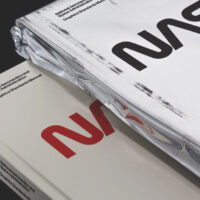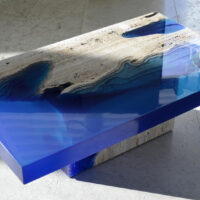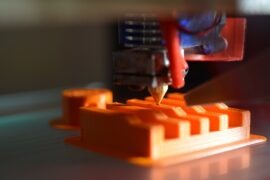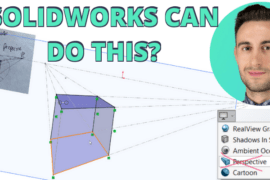Two weeks ago we did the unthinkable. We taped back our eyelids, slapped on some CAD spandex (that exists right?) and launched a series of articles on Fusion 360. It’s finally time we took a deeper dive into the toolset and explore: Part Modeling, Assembly Modeling, Simulation, CAM, and Collaboration. This week, we’re going to start smack dab in the comfy confines of our home field – Part Modeling. While Autodesk touts Fusion 360 is in a class of design tools that that go beyond 1990’s CAD in the cloud, it needs to have those futuristic features as a foundation to prove it. Let’s have a look, shall we?
I’ve not done any big, commercial projects in Fusion 360, but have done some small designs and have shown the kiddos how to go about using it. It may sound odd coming from someone who has spent 20 years (?!) using SolidWorks, but I actually find the sketching and modeling quite intuitive. I did however have do a little bit of that thing called LEARNING. I even figured out how to ‘Select Other’ when I was listening to Beastie Boys and held my LMB down for too long. Money makin’, money, money makin’.
But here’s a question for you. What’s your process for going between modeling and sculpting, or sculpting and modeling? With the form editing power in Fusion 360, that’s the one process I want to master. I’m getting ahead of myself, though. Let’s start off with some light mental stretching… Nah, let’s go ahead and blow your mind with the most over the top, simple concept that I’ve not seen in any other CAD system.
Delete
Delete? Say what? What’s so flippin’ special about deleting something in Fusion 360? Well, speed for one thing. This is how Fusion 360 handles deleting faces, features, bodies, or components. First, it magically understands what each of those are. Then, when you nub-punch the Delete-key, it adjusts the geometry accordingly. In order to delete a body or face in SolidWorks, you decide which one you want to do first. Select a face, then decide to delete, patch or fill. Delete a body and… great, the features are merged and you’ve got the pain of redoing references and updating features. I do like the approach in Fusion 360 and have yet to experience any oddities with it.
Boundary Fill
If you’re an old school boolean modeler this feature might turn your skeptical frown upside down. (I know you’re making that face.) Boundary Fill joins or removes volumes using bounding volumes formed by tool selections. It’s similar to Intersect, Combine and Subtract Features in SolidWorks, but this works across multiple bodies and components, or a combination of the two. Then you get an option as to what to do with the resulting geometry – Join, Cut or Intersect or even New Body, or New Component.
Move Face
We all know direct modeling has been around for a while, but Fusion 360… wait for it… FUSED parametric, surface, freeform, and direct into the same package. Fused. Clever. I’m pretty sure that was intended though. It’s relevant for this example because of the ability to flip that feature history on and off, you can move geometry around without worrying about getting a little knot in your feature tree.
Oh, and here’s an added bonus. Re-anchor. This would be used in a case where you need to move a feature in relation to a reference point. I can grab a face or body, select ‘Re-anchor’ from the dimension pop-up and redefine that feature from another point. It doesn’t change that any initial dimension or reference point. It just allows me to define an exact dimension from a different reference point. Love it.

Symmetry
Now for the really fun stuff. This is what I love so much about Fusion 360. In the Sculpt Workspace, the Symmetry feature says, “make the other side of the part look like this side.” This is a must use feature, but the way it was incorporated is super slick. You don’t have to enable symmetry prior to selecting the Edit Form command. You can enable it as needed. For example, you’ve spent time modeling a yak saddle, using symmetry in some spots and not in others. You realize the front of the yak saddle needs to be symmetrical, because you’ve decide to part your yak’s mane evenly on both sides. Select Symmetry, pick your faces, watch it update. No need to undo a bunch of work you’ve already done. And, happy yak.
Edit Form
T-Splines at it’s finest right here folks. No words… just watch.
Cool ‘lil quick tip with Edit Form. Hold down the Alt-key, it adds the faces as you see in the GIF so that you don’t have to go back and split faces. Loooooovely. Yes, I could model that part in SolidWorks. You and I both know it would just take longer.
Summary
Ok, so I really hate to stop there, but we’ve got this ‘5 features’ thing going on, and these are the ones that show a bit of the difference in Fusion 360 part modeling. I know some of these features and concepts are not necessarily ground-breaking, but what I keep coming back to is how they’re all together in Fusion 360–the parametric, the direct, and the sculpting. That’s what makes Fusion 360 unique in this case. And this is where I would like to circle back to how you take on a workflow between the three. With the power that combines, how are you going between modeling and sculpting, or sculpting and modeling?
By the way, when I first tried Fusion 360, I snagged it for free and at $300 annually, the price still amazes me for everything it can do. Snag Fusion 360 for yourself here.










![6 Types of Civil Engineering Drawings [Detailed Guide]](https://www.solidsmack.com/wp-content/uploads/2023/12/Civil-Engineering-Drawings-270x180.jpeg)

